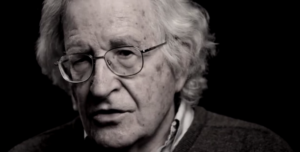Noam Chomsky: Another World Is Possible. Let’s Bring It To Reality
It’s a truism that the world is in a dismal state; indeed, there are too many great challenges facing our world and the planet is in fact at a breaking point, as Noam Chomsky elaborates on an exclusive interview below for Truthout. What’s less widely recognized is that another world is possible because the present one is simply not sustainable, says one of the world’s greatest public intellectuals.
Chomsky is institute professor emeritus in the Department of Linguistics and Philosophy at MIT and laureate professor of linguistics and Agnese Nelms Haury Chair in the Program in Environment and Social Justice at the University of Arizona. One of the world’s most-cited scholars and a public intellectual regarded by millions of people as a national and international treasure, Chomsky has published more than 150 books in linguistics, political and social thought, political economy, media studies, U.S. foreign policy and world affairs. His latest books are Illegitimate Authority: Facing the Challenges of Our Time (forthcoming; with C.J. Polychroniou); The Secrets of Words (with Andrea Moro; MIT Press, 2022); The Withdrawal: Iraq, Libya, Afghanistan, and the Fragility of U.S. Power (with Vijay Prashad; The New Press, 2022); and The Precipice: Neoliberalism, the Pandemic and the Urgent Need for Social Change (with C.J. Polychroniou; Haymarket Books, 2021).
C.J. Polychroniou: Noam, as we enter a new year, I want to start this interview by asking you to highlight the biggest challenges facing our world today and whether you would agree with the claim that human progress, while real and substantial in some regards, is neither even nor inevitable?
Noam Chomsky: The easiest way to respond is with the Doomsday Clock, now set at 100 seconds to midnight, likely to advance closer to termination when it is reset in a few weeks. As it should, considering what’s been happening in the past year. The challenges it highlighted last January remain at the top of the list: nuclear war, global heating, and other environmental destruction, and the collapse of the arena of rational discourse that offers the only hope for addressing the existential challenges. There are others, but let’s look at these.
Washington has just agreed to provide Ukraine with Patriot missiles. Whether they work or not is an open question, but Russia will assume a worst-case analysis and consider them a target. We have few details, but it’s likely that U.S. trainers come with the missiles, hence are targets for Russian attack, which might move us a few steps up the escalation ladder.
That’s not the only possible ominous scenario in Ukraine, but the threats of escalation to unthinkable war are not just there. It’s dangerous enough off the coast of China, particularly as Biden has declared virtual war on China and Congress is seething at the bit to break the “strategic ambiguity” that has maintained peace regarding Taiwan for 50 years, all matters we’ve discussed before.
Without proceeding, the threat of terminal war has increased, along with foolish and ignorant assurances that it need not concern us.
Let’s turn to the environment. On global warming, the news ranges from awful to horrendous, but there are some bright spots. The Biodiversity Convention is a major step toward limiting the lethal destruction of the environment. Support is almost universal, though not total. One state refused to sign, the usual outlier, the most powerful state in world history. The GOP, true to its principles, refuses to support anything that might interfere with private power and profit. For similar reasons, the U.S. refused to sign the Kyoto Protocols on global warming (joined in this case by Andorra), setting in motion a disastrous failure to act that has sharply reduced the prospects for escape from catastrophe.
I don’t mean to suggest that the world is saintly. Far from it. But the global hegemon stands out.
Let’s turn to the third factor driving the Doomsday Clock toward midnight: the collapse of the arena of rational discourse. Most discussion of this deeply troubling phenomenon focuses on outbursts in social media, wild conspiracy theories, QAnon and stolen elections, and other dangerous developments that can be traced in large part to the breakdown of the social order under the hammer blows of the class war of the past 40 years. But at least we have the sober and reasoned domain of liberal intellectual opinion that offers some hope of rational discourse.
Or do we?
What we see in this domain often defies belief — and evokes ridicule outside of disciplined Western circles. For example, the leading establishment journal of international affairs soberly informs us that a Russian defeat “would reinforce the principle that an attack on another country cannot go unpunished.”
The journal is referring to the principle that has been upheld so conscientiously when we are the agents of aggression — a thought that surfaces only among those who commit the unpardonable crime of applying to ourselves the principles that we valiantly uphold for others. It’s hard to imagine that the thought has never surfaced in the mainstream. But it’s not easy to find.
Sometimes what appears is so outlandish that one is entitled to wonder what may lie behind it, since the authors can’t believe what they are saying. How, for example, can someone react to a story headlined “No conclusive evidence Russia is behind Nord Stream attack,” going on to explain that, “World leaders were quick to blame Moscow for explosions along the undersea natural gas pipelines. But some Western officials now doubt the Kremlin was responsible,” even though the Russians probably did it in order to “strangle the flow of energy to millions across the continent”?
It’s true enough that much of the West was quick to blame Russia, but that’s as informative as the fact that when something goes wrong, Russian apparatchiks are quick to blame the U.S. In fact, as most of the world recognized at once, Russia is about the least likely culprit. They gain nothing from destroying a valuable asset of theirs; Russian state-owned Gazprom is the major owner and developer of the pipelines, and Russia is counting on them for revenue and influence. If they wanted to “strangle the flow of energy,” all they would have to do is to close some valves.
As the sane parts of the world also recognized at once, the most likely culprit is the only one that had both motive and capability. U.S. motive is not in question. It has been publicly proclaimed for years. President Biden explicitly informed his German counterparts, quite publicly, that if Russia invaded Ukraine the pipeline would be destroyed. U.S. capability is of course not in question, even apart from the huge U.S. naval maneuvers in the area of the sabotage just before it took place.
But to draw the obvious conclusion is as ludicrous as holding that the noble “principle that an attack on another country cannot go unpunished” might apply when the U.S. attacks Iraq or anyone else. Unspeakable.
What then lies beyond the comical headline “No conclusive evidence Russia is behind Nord Stream attack” — the Orwellian translation of the statement that we have overwhelming evidence that Russia was not behind the attack and that the U.S. was.
The most plausible answer is the “thief, thief” technique, a familiar propaganda device: When you’re caught with your hands in someone’s pocket, don’t deny it and be easily refuted. Rather, point somewhere else and shout “thief, thief,” acknowledging that there is a robbery while shifting attention to some imagined perpetrator. It works very well. The fossil fuel industry has been practicing it effectively for years, as we’ve discussed. It works even better when embellished by the standard techniques that make U.S. propaganda so much more effective than the heavy-handed totalitarian variety: foster debate to show our openness, but within narrow constraints that instill the propaganda message by presupposition, which is much more effective than assertion. So, highlight the fact that there is skepticism about Russian depravity, showing what a free and open society we are while establishing more deeply the ludicrous claim that the propaganda system is seeking to instill.
There is, to be sure, another possibility: Perhaps segments of the intellectual classes are so deeply immersed in the propaganda system that they actually can’t perceive the absurdity of what they are saying.
Either way, it’s a stark reminder of the collapse of the arena of rational discourse, right where we might hope that it could be defended.
Unfortunately, it’s all too easy to continue.
In short, all three of the reasons why the Clock had been moved to 100 seconds to midnight have been strongly reinforced in the past year. Not a comforting conclusion, but inescapable.
Scientists are warning us that global warming is such an existential threat to the point that civilization is headed toward a major catastrophe. Are apocalyptic claims or views about global warming helpful? Indeed, what will it take to achieve successful climate action, considering that the most powerful nation in history is actually “a rogue state leading the world toward ecological collapse,” as George Monbiot aptly put it in a recent op-ed in The Guardian?
The Yale University Climate program on climate and communication has been conducting studies on how best to bring people to understand the reality of the crisis facing humanity. There are others, from various perspectives.
It is a task of particular importance in the “rogue state leading the world toward ecological collapse.” It is also a task of difficulty, given that denialism not only exists in some circles but has been close to official policy in the Republican Party ever since this extremist organization succumbed to the offensive of the Koch energy conglomerate, launched when the party seemed to be veering toward sanity during the 2008 McCain campaign. When party loyalists hear their leaders, and their media echo chamber, assuring them “not to worry,” it’s not easy to reach them. And though extreme, the GOP is not alone.
It seems to be generally agreed that apocalyptic pronouncements are not helpful. People either tune off or listen and give up: “It’s too big for me.” What seems to be more successful is focusing on direct experience and on steps that can be taken, even if small. All of this is familiar to organizers generally. It’s a hard path to follow for those who are aware of the enormity of the crisis. But efforts to reach people have to be tailored to their understanding and concerns. Otherwise, they can descend to self-serving preaching to a void.
Recently, we discussed in another interview the aims and effects of neoliberal capitalism. Now, neoliberalism is often enough conflated with globalization, but it is rather obvious that the latter is a multidimensional process that has existed long before the rise of neoliberalism. Of course, the dominant form of globalization today is neoliberal globalization, but this is not to say that globalization must be structured around neoliberal policies and values, or to think that “there is no alternative.” There are indeed continuous struggles across the world for democratic control over states, markets and corporations. My question thus is this: Is it utopian thinking to believe that the status quo can be challenged and that another world is possible?
Globalization simply means international integration. It can take many forms. The neoliberal globalization crafted mostly during the Clinton years was designed in the interest of private capital, with an array of highly protectionist investor-rights agreements masked as “free trade.” That was by no means inevitable. Both the labor movement, and Congress’s own research bureau (the Office of Technology Assessment, or OTA) proposed alternatives geared to the interests of working people in the U.S. and abroad. They were summarily dismissed. The OTA was disbanded, according to reports, because Newt Gingrich’s GOP regarded it as biased against them, though it may be that Clintonite New Democrats shared the sentiment about fact and reason. Capital flourished, including the mostly predatory financial system. Labor was severely weakened, with consequences that reverberate to the present.
Globalization could take a very different form, just as economic arrangements can quite generally. There is a long history of efforts to separate the political from the economic domain, the latter conceived as purely objective, like astronomy, guided by specialists in the economics profession and immune to the agency of ordinary citizens, labor in particular. One very impressive recent study, by Clara Mattei, argues persuasively that this dichotomy, typically taking the form of austerity programs, has been a major instrument of class war for a century, paving the way to fascism, which was indeed welcomed by Western elite opinion, with enthusiasm by “libertarians.”
There is, however, no reason to accept the mythology. The political domain in a broad sense, including labor and other popular activism, can shape the economic system in ways that will benefit people, not profit and private power. The rise of social democracy illustrates that well, but there is also no reason to accept its tacit assumption that capitalist autocracy is a law of nature. To quote Mattei, “either the organizations of people can move beyond capitalist relations [to economic democracy], or the ruling class will reimpose its rule.”
The status quo can certainly be challenged. A far better world is surely within reach. There is every reason to honor the slogan of the World Social Forum that “Another world is possible,” a far better one, and to devote our efforts to bring it to reality.
Copyright © Truthout. May not be reprinted without permission.
C.J. Polychroniou is a political scientist/political economist, author, and journalist who has taught and worked in numerous universities and research centers in Europe and the United States. Currently, his main research interests are in U.S. politics and the political economy of the United States, European economic integration, globalization, climate change and environmental economics, and the deconstruction of neoliberalism’s politico-economic project. He is a regular contributor to Truthout as well as a member of Truthout’s Public Intellectual Project. He has published scores of books and over 1,000 articles which have appeared in a variety of journals, magazines, newspapers and popular news websites. Many of his publications have been translated into a multitude of different languages, including Arabic, Chinese, Croatian, Dutch, French, German, Greek, Italian, Japanese, Portuguese, Russian, Spanish and Turkish. His latest books are Optimism Over Despair: Noam Chomsky On Capitalism, Empire, and Social Change (2017); Climate Crisis and the Global Green New Deal: The Political Economy of Saving the Planet (with Noam Chomsky and Robert Pollin as primary authors, 2020); The Precipice: Neoliberalism, the Pandemic, and the Urgent Need for Radical Change (an anthology of interviews with Noam Chomsky, 2021); and Economics and the Left: Interviews with Progressive Economists (2021).





